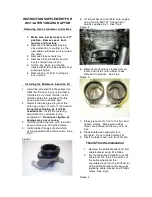
STARTING AND DRIVING
408
Emergency brake lights
Emergency brake lights are activated to alert
vehicles behind about heavy braking. The func-
tion means that the brake light flashes instead of
- as in normal braking - shining with a constant
glow.
The emergency brake lights are activated during
heavy braking or if the ABS system is activated at
high speeds. After emergency braking to a low
speed, the brake lights return from flashing to the
normal constant glow. The car's hazard warning
flashers are activated at the same time. These
flash until the driver accelerates the car to a
higher speed again or switches off the hazard
warning flashers.
Related information
•
•
Hazard warning flashers (p. 143)
•
Brake assistance
The brake assist system, BAS (Brake Assist
System), helps to increase brake force during
braking, thereby shortening the braking distance.
The system detects the way in which the driver
brakes and increases brake force where neces-
sary. The brake force can be boosted up to the
level when the ABS system is engaged. The
function is suspended when the pressure on the
brake pedal decreases.
When BAS is activated the brake pedal low-
ers slightly more than usual, depress (hold)
the brake pedal as long as necessary.
When the brake pedal is released, all braking
ceases.
Related information
•
Auto braking after a collision
In the event of a collision in which the activation
level is reached for the pyrotechnic seatbelt ten-
sioners or airbags, or if a collision with a large
animal is detected, the car's brakes are automat-
ically applied. This function is to prevent or
reduce the effects of any subsequent collision.
After a serious collision there is a risk that it is no
longer possible to control and steer the car. In
order to avoid or mitigate a possible further colli-
sion with a vehicle or an object in the vehicle's
path, the auto braking system is activated auto-
matically and brakes the car in a safe manner.
Brake lights and hazard warning lights are acti-
vated during braking. When the car has stopped,
the hazard warning lights continue to flash and
the parking brake is applied.
If braking is not appropriate, e.g. if there is a risk
of being hit by following traffic, the system can be
overridden by the driver depressing the accelera-
tor pedal.
The function assumes that the brake system is
intact after the collision.
See also the sections "Rear Collision Warning"
and "Blind Spot Information".
Related information
•
•
•
Summary of Contents for V 90 Cross Country
Page 1: ...OWNER S MANUAL...
Page 2: ......
Page 14: ......
Page 15: ...INTRODUCTION...
Page 57: ...SAFETY...
Page 87: ...INSTRUMENTS AND CONTROLS...
Page 182: ......
Page 183: ...CLIMATE CONTROL...
Page 218: ......
Page 219: ...LOADING AND STORAGE...
Page 237: ...LOCKS AND ALARM...
Page 273: ...DRIVER SUPPORT...
Page 384: ......
Page 385: ...STARTING AND DRIVING...
Page 435: ...AUDIO AND MEDIA...
Page 479: ...AUDIO AND MEDIA 477 Country Area Korea B B Taiwan...
Page 483: ...WHEELS AND TYRES...
Page 506: ......
Page 507: ...MAINTENANCE AND SERVICE...
Page 558: ......
Page 559: ...SPECIFICATIONS...
Page 578: ......
Page 592: ...ALPHABETICAL INDEX 590...
Page 593: ......
















































